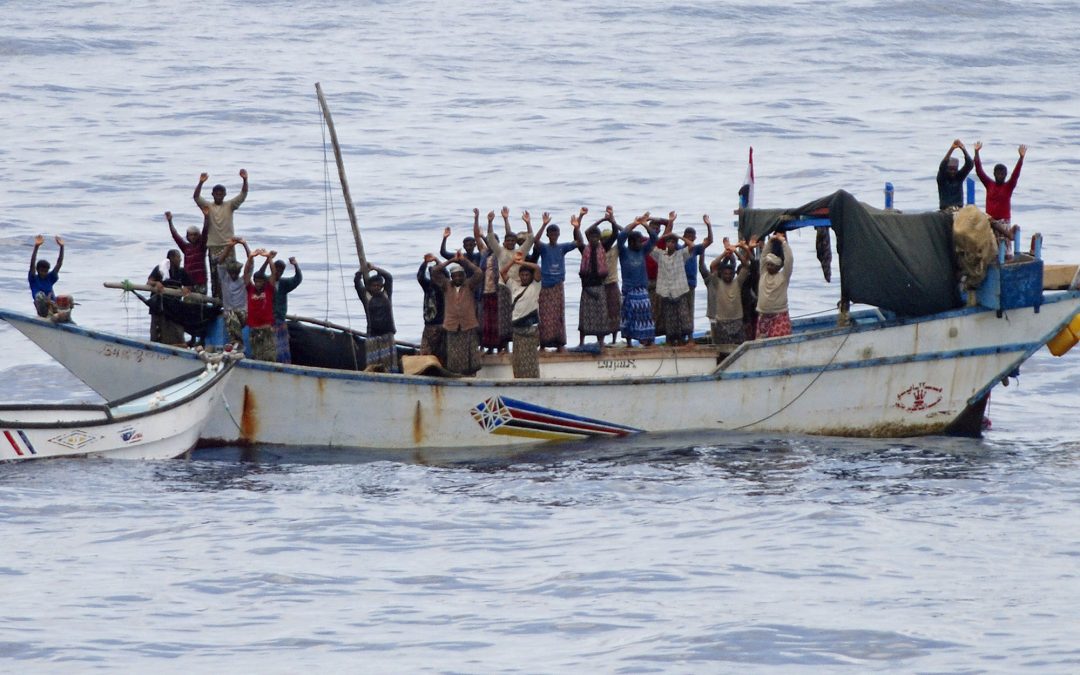Piracy has existed for as long as there has been maritime trade; it conjures images of sail ships, the jolly roger, treasure and buccaneers on the seven seas. Pirates in the twenty first century, however, are more familiar with semi-automatic weapons than a cutlass, while their treasure is less gold doubloons than hostages and the latest electric goods.
According to the International Maritime Bureau (“IMB”), piracy can be defined as “the act of boarding any vessel with intent to commit theft or any other crime, and with an intent or capacity to use force in furtherance of that act”. Stamping out piracy is an ongoing battle, but in recent years we have seen some positive trends. Somali waters are perhaps the most well-known location of the modern-day pirates, largely due to headlines generated during the 2000s. Since then, the region has managed to significantly reduce numbers of piracy incidents, in part due to surveillance from the air and sea, and an increased international cooperation between countries’ navies. Though it is considered that the decisive factor was a concerted effort to improve security measures aboard vessels, particularly through the use of armed guards. This fall in numbers is – at face value – a global trend, with incidents of piracy falling worldwide in recent years.
2020 is, however, on course to buck this downward trend. The IMB’s Piracy Reporting Centre recorded 98 incidents of piracy and armed robbery in the first half of 2020, up from 78 in the first half of 2019.
New era, new tactics?
The traditional modus operandi for pirates has not evolved dramatically over the years. It involves attacking vessels from astern, often at night, using grappling hooks and ropes to board the ship before anyone raises the alarm. To mitigate against this, vessels have long been warned not to drop anchor in high-risk areas and are increasingly being advised of the dangers of even drifting in these zones.
Where pirates have evolved is their capability to target ships at increasing distances from the coastline. We are typically seeing attacks take place between 45 and 75 nautical miles out to sea. There are also incidents recorded as far as 400 nautical miles from the shoreline. In these incidents, smaller ships are working in conjunction with a larger mothership that carries fuel, supplies and ammunition. Further, attacks are also becoming increasingly common during daylight hours.
Victims of piracy are often simply in the wrong place at the wrong time. In the vast expanse of the ocean pirates may just pick the first vessel they come across. There have been incidents however of pirates utilising open source intelligence and modern technology, specifically online tracking apps and surveillance equipment to target vessels. It is impossible to estimate how widespread the use of this technology is but in one recorded hijacking incident in 2017, in the South China Sea, the pirates monitored the online Marine Traffic system and used the Ship Finder app to follow the movements of the targeted ship. There is also anecdotal evidence of Somali pirates researching information on vessels and the counter measures being employed to combat them. There are various ship tracking apps freely available online which include huge swaths of detail on potential targets including images of vessels, types of vessel i.e.: tanker or cargo vessel and their proposed routes. These are all hugely valuable bits of information and it is not a leap to imagine how they might be used increasingly by pirates to scope out targets and plan their attack vectors.
There has also been some suggestion that informants are providing access to ship information making it possible for pirates to locate target specific vessels, which may have cargo of value, in the vast expanses of the sea. Crews of some hijacked vessels have said that the pirates appear to know specific details about the ship including its layout.
Kidnap for ransom is also trending as it is much easier, quicker and often more profitable to take human cargo rather than the entire vessel – which may be difficult to house and control. This trend is being driven primarily by events in The Gulf of Guinea were violence towards crew is also an increasing risk. Between January and July of this year 77 crew were taken hostage or kidnapped according to IMB’s half year report. The Gulf of Guinea accounted for 49 of these kidnappings. The maritime pirates operating in the Gulf of Guinea, like the Somali pirates of old, are known to have strong connections to their land-based counterparts, especially those operating in the Niger Delta – notorious for kidnap for ransom gangs. This gives them unique access to the markets that profit from piracy activity.
Piracy is still rooted in a tried and tested model, but there is evidence of its evolution from basic armed robberies. The relationship with land-based groups demonstrates an operation that goes beyond regional borders. While modern technology will continue to improve a pirate’s capability and opportunities which means seafarers must continue to be vigilant and stay informed of trends.
Where are the hotspots?
There are four traditional hotspots for piracy: the Gulf of Aden, associated with Somali pirates of the 2000s; Southeast Asia; the Gulf of Mexico; and finally, the Gulf of Guinea which reportedly accounts for the majority of maritime kidnappings in the world. There is a concern though that an economic downturn, of the sort caused by the COVID 19 pandemic, will cause a rise in piracy in other regions of the world as individuals search out alternative means of income.
Though very different parts of the world, the same factors explain why piracy has risen in these areas:
– Corruption;
– The weak rule of law and unstable governments mean authorities are unable to respond to the threats;
– Economic conditions have led some people to resort to illegal activity. Piracy is a lucrative job.
These factors are likely to be exacerbated by the COVID 19 pandemic as security is directed to other priorities and the global economy suffers a downturn. This is reflected in the number of kidnap incidents since lockdown; with 32 of the 49 crew kidnap incidents in the Gulf of Guinea during the first half of this year occurring between May and July.
Gulf of Mexico
Maritime security officials say attacks have returned in the Gulf of Mexico due to instability in the region. The security forces available are also focused on inland issues during the current pandemic. When Mexico opened its oil industry to international investment it led to that sector being seen as a lucrative target. Though private sector involvement has been rolled back since Lopez Obrador became President, attacks are still occurring on ships and platforms tied to Mexico’s oil industry, robbing crews of money and seizing personal belongings and technical equipment.
Reports emerged indicating that on 24 July a group of armed pirates targeted an offshore supply vessel which was conducting operations near the Odin Offshore platform off the coast of Coatzacoalcos, Veracruz state.
The attacks in the gulf have persisted into the summer, causing the U.S. government in June to issue a special security alert for the region, singling out the Bay of Campeche as a particularly perilous region.
Asia
The number of piracy and armed robbery incidents reported in Asian waters has more than doubled in the first half of 2020 compared to last year. There were 51 incidents reported from January to June this year, compared with 28 for the same period in 2019.
The most high-profile incident in Asia took place in January, when pirates boarded a fishing trawler off the east coast of the Malaysian state of Sabah and abducted eight crew members. Six months later, five crew members are still being held in captivity.
The half-yearly statistics were released by the Regional Cooperation Agreement on Combating Piracy and Armed Robbery against Ships in Asia (ReCAAP) Information Sharing Centre on 16 July. Most of the incidents in the Singapore Strait this year occurred in the hours of darkness and involved bulk carriers – although tankers and tug-boats were also targeted. ReCAAP has attributed a lack of law enforcement, patrol and surveillance to the spike in incidents.
Gulf of Guinea
The Gulf of Guinea off West Africa is increasingly dangerous for commercial shipping, accounting for the majority of maritime kidnappings worldwide.
Where Asia may experience the most piracy incidents, which are generally thefts, the Gulf of Guinea, particularly the Niger River Delta region, is the most perilous route for ships’ crews.
“The violence towards the crew is quite high and significant,” says Cyrus Mody, Assistant Director for Commercial Crime Services at the International Chamber of Commerce. “The incidents are targeted at the kidnappings of the crew and the attacks are a lot more violent than other parts of the world”. “Violence against crews is a growing risk in a workforce already under immense pressure,” says IMB Director Michael Howlett. “In the Gulf of Guinea attackers armed with knives and guns now target crews on every type of vessel. Everyone’s vulnerable.”
In total, IMB’s Piracy Reporting Centre (PRC) reports that 49 crew have been kidnapped in 2020, 32 between May and July, for ransom in the Gulf of Guinea and held captive on land for on average up to six weeks.[1]
Attempts to mitigate this are hampered somewhat by the fact that none of the countries in this region allow for private security on board. Only those with memoranda of understanding with local navies, who in turn provide security, are allowed to operate. This obviously comes at a premium.
Gulf of Aden
The security focus less than a decade ago was in the Gulf of Aden, regarded then as the most dangerous waters in the world. Somali pirates persistently hijacked large cargo ships. But a combination of coordinated international naval efforts, improved local governments and enhanced security measures aboard ships, including armed personnel, reduced the threat of pirates off the East African coast.
What’s the authorities’ response?
The response to maritime piracy requires state cooperation; to date three agreements have been set up in different regions of the world. The members to these regional agreements agree to arrest, investigate, and prosecute pirates on the high seas, and to suppress armed robbery in their respective territorial waters.
– In Asia, the Regional Cooperation Agreement on Combating Piracy and Armed Robbery against Ships in Asia (ReCAAP) was established in 2006;
– In East Africa, the Djibouti Code of Conduct (DCoC) was agreed on in 2009;
– Finally, the Yaoundé Code of Conduct (YCoC) to combat illicit maritime activities in West and Central Africa was signed in 2013 by 25 regional states.
The collection and dissemination of data on maritime crimes is one of the most important practical tasks carried out by the regional agreements, because to efficiently coordinate cooperation between maritime security actors it is crucial to have available all relevant information on the threat at hand. Furthermore, by creating reliability, regular information sharing has the potential to strengthen trust and confidence among key actors.
While the setup of the regional agreements is certainly a milestone in counterpiracy governance, the different regions are faced with a variety of challenges concerning cooperation in general and the implementation of the agreements’ provisions, in particular:
– Concerns over territorial sovereignty;
– Lack of national capacities;
– Gaps in scope.
Looking ahead, threats to maritime security cannot be understood in isolation, as they are deeply interrelated and tied into international trends.
What can you do to stay safe from piracy?
For those operating in the area the best advice is to engage a professional maritime security advisor. They will be up to date with all the latest guidance and best practice, including onboard security and advice on how to navigate high risk areas. Furthermore, they will also be up to date on the latest trends and hotspots to help you best prepare your route.
Source:- Hellenic Shipping News






